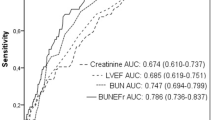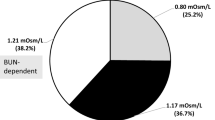Abstract
Contrast-induced nephropathy (CIN) is a common complication following percutaneous coronary intervention (PCI). Contrast-induced nephropathy after emergency PCI in subjects with insulin resistance (IR) has not been studied before. In this prospective study we determined the relation between IR on CIN, among those undergoing PCI due to acute coronary syndrome. One hundred twenty four consecutive acute coronary syndrome patients with diabetes (N = 44), insulin resistance (N = 38) and normal glycemic metabolism (N = 42) were included in the study. They were all treated with PCI. Pre- and post procedural creatinines were measured and independent predictors of CIN were analyzed. IR was defined as a HOMA level (HOMA-IR = Serum Glucose (mg/dL) X Plasma Insulin (micro unit/mL) / 405 >2.5. Patients with IR or diabetes had significantly higher levels of creatinine after procedure, serum cholesterol, glucose, contrast volume, hospital stay and HOMA. Female gender, frequency of CIN and multivessel disease were also higher in these patients. On the other hand they had significantly lower ejection fraction. Logistic regression analysis showed that HOMA was the single independent risk factor for CIN in patients with acute coronary syndrome treated with PCI. Insulin resistance is an independent risk factor for CIN in patients with acute coronary syndrome treated with PCI. It carries a similar risk with diabetes and proper prophylaxis should be performed.
Similar content being viewed by others
References
Chong E, Poh KK, Liang S, Tan HC. Risk factors and clinical outcomes for contrast-induced nephropathy after percutaneous coronary intervention in patients with normal serum creatinine. Ann Acad Med Singapore. 2010;39:374–80.
Senoo T, Motohiro M, Kamihata H, Yamamoto S, Isono T, Manabe K, et al. Contrast-induced nephropathy in patients undergoing emergency percutaneous coronary intervention for acute coronary syndrome. Am J Cardiol. 2010;105:624–8.
Wang XC, Fu XH, Wang YB, Jia XW, Wu WL, Gu XS, et al. Prediction of contrast-induced nephropathy in diabetics undergoing elective percutaneous coronary intervention: role of the ratio of contrast medium volume to estimated glomerular filtration rate. Chin Med J. 2011;124:892–6.
Toprak O, Cirit M, Yesil M, Bayata S, Tanrisev M, Varol U, et al. Impact of diabetic and pre-diabetic state on development of contrast-induced nephropathy in patients with chronic kidney disease. Nephrol Dial Transplant. 2007;22:819–26.
Rihal CS, Textor SC, Grill DE, Berger PB, Ting HH, Best PJ, et al. Incidence and prognostic importance of acute renal failure after percutaneous coronary intervention. Circulation. 2002;105:2259–64.
Tepel M, Aspelin P, Lameire N. Contrast-induced nephropathy: a clinical and evidence-based approach. Circulation. 2006;113:1799–806.
Okumura K, Sone T. Risk assessment and prevention of contrast-induced nephropathy in patients undergoing coronary angiography. Intern Med. 2012;51:519–21.
Ascaso JF, Pardo S, Real JT, Lorente RI, Preiego A, Carmena R. Diagnosing insulin resistance by simple quantitative methods in subjects with normal glucose metabolism. Diabetes Care. 2003;26:3320–5.
Genuth S, Alberti KG, Bennett P, Buse J, Defronzo R, Kahn R, et al. Follow-up report on the diagnosis of diabetes mellitus. Expert committee on the diagnosis and classification of diabetes mellitus. Diabetes Care. 2003;26:3160–7.
Wickenbrock I, Perings C, Maagh P, Quack I, van Bracht M, Prull MW, et al. Contrast medium induced nephropathy in patients undergoing percutaneous coronary intervention for acute coronary syndrome: differences in STEMI and NSTEMI. Clin Res Cardiol. 2009;98:765–72.
Toprak O, Cirit M. Risk factors for contrast-induced nephropathy. Kidney Blood Press Res. 2006;29:84–93.
Bakris GL, Lass N, Gaber AO, Jones JD, Burnett Jr JC. Radiocontrast medium-induced declines in renal function: a role for oxygen free radicals. Am J Physiol. 1990;258:115–20.
Clark BA, Kim D, Epstein FH. Endothelin and atrial natriuretic peptide levels following radiocontrast exposure in humans. Am J Kidney Dis. 1997;30:82–6.
Detrenis S, Meschi M, Musini S, Savazzi G. Lights and shadows on the pathogenesis of contrast-induced nephropathy: state of the art. Nephrol Dial Transplant. 2005;20:1542–50.
Festa A, Hanley AJ, Tracy RP, D’Agostino Jr R, Haffner SM. Inflammation in the prediabetic state is related to increased insulin resistance rather than decreased insulin secretion. Circulation. 2003;108:1822–30.
Diamant M, Tushuizen ME. The metabolic syndrome and endothelial dysfunction: common highway to type 2 diabetes and CVD. Curr Diab Rep. 2006;6:279–86.
Piatti PM, Monti LD, Galli L, Fragasso G, Valsecchi G, Conti M, et al. Relationship between endothelin-1 concentration and metabolic alterations typical of the insulin resistance syndrome. Metabolism. 2000;49:748–52.
Andronico G, Mangano M, Ferrara l, et al. In vivo relationship between insulin and endothelin role of insulin-resistance. J Hum Hypertens. 1997;11:63–6.
Skalska A, Gasowski J, Grodzicki T. Antioxidants modify the relationship between endothelin-1 level and glucose metabolism-associated parameters. Metabolism. 2009;58:1229–33.
Parfrey P. The clinical epidemiology of contrast-induced nephropathy. Cardiovasc Intervent Radiol. 2005;28:3–11.
McCullough P. Outcomes of contrast-induced nephropathy: experience in patients undergoing cardiovascular intervention. Catheter Cardiovasc Interv. 2006;67:335–43.
Marenzi G, Lauri G, Assanelli E, Campodonico J, De Metrio M, Marana I, et al. Contrast-induced nephropathy in patients undergoing primary angioplasty for acute myocardial infarction. J Am Coll Cardiol. 2004;44:1780–5.
Conflict of interest
None declared.
Author information
Authors and Affiliations
Corresponding author
Rights and permissions
About this article
Cite this article
Elbey, M.A., Evliyaoglu, O., Simsek, Z. et al. Impact of insulin resistance on contrast induced nephropathy in patients undergoing percutaneous coronary intervention. Int J Diabetes Dev Ctries 34, 40–44 (2014). https://doi.org/10.1007/s13410-013-0140-4
Received:
Accepted:
Published:
Issue Date:
DOI: https://doi.org/10.1007/s13410-013-0140-4




